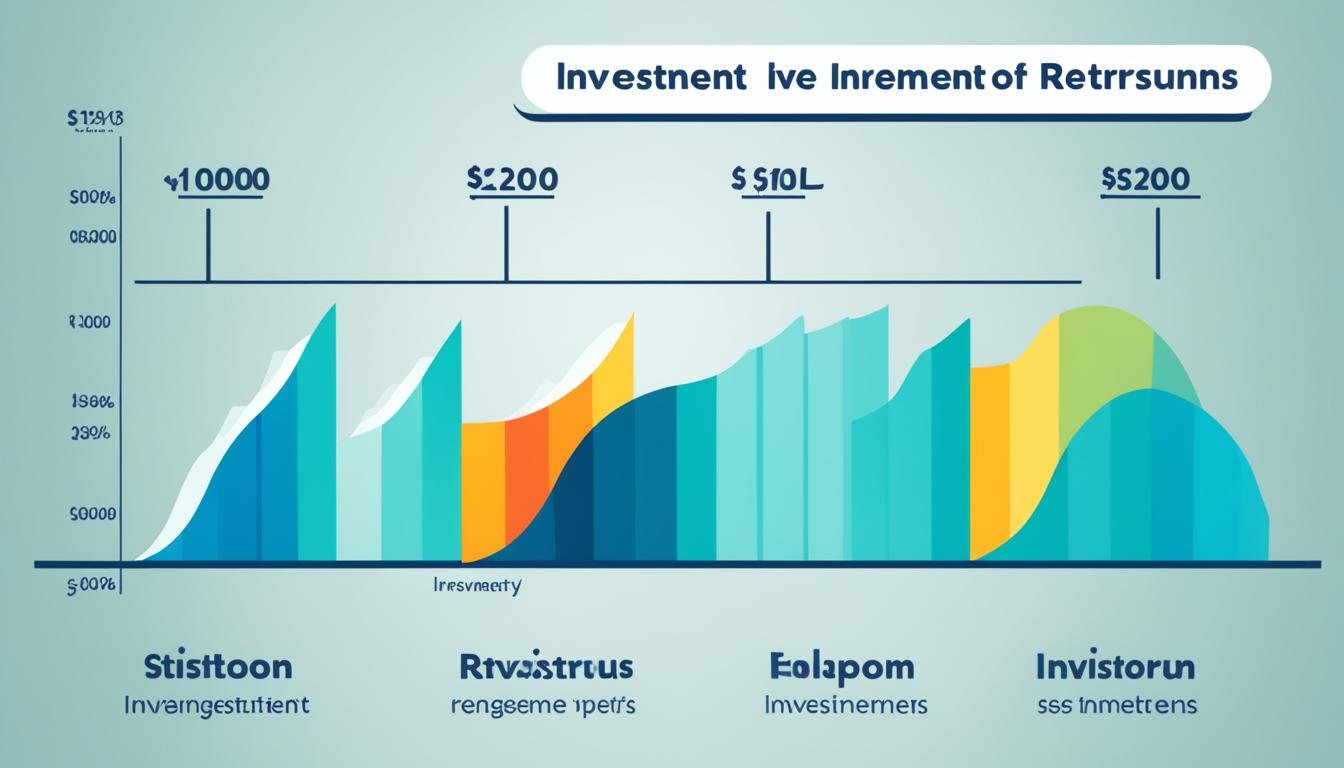Investment Appraisal Techniques
Welcome to our comprehensive guide on investment appraisal techniques. In today’s fast-paced and competitive business landscape, making informed investment decisions is crucial for individuals and organizations alike. By utilizing effective financial analysis methods and capital budgeting tools, investors can evaluate the viability of potential projects and maximize their returns.
Proper evaluation of investment opportunities involves the calculation of key metrics, such as the Net Present Value (NPV), Internal Rate of Return (IRR), and the payback period. Additionally, discounted cash flow analysis and project profitability analysis play vital roles in assessing the financial performance of investments.
Key Takeaways:
- Investment appraisal techniques are essential for assessing the viability of projects.
- Financial analysis methods and capital budgeting tools aid in making informed investment decisions.
- Calculating metrics like NPV, IRR, and payback period enables accurate evaluation of projects.
- Discounted cash flow analysis helps determine the present value of future cash flows.
- Project profitability analysis provides insights into the financial performance of investments.
Understanding Investment Appraisal
Investment appraisal is a crucial process in financial decision-making. Before committing resources to a project, it is essential to evaluate its feasibility and potential viability. This section will provide a deeper understanding of investment appraisal and highlight the key factors to consider in project evaluation.
With investment appraisal, individuals and businesses can make informed decisions regarding resource allocation. By carefully assessing projects, they can minimize risks and maximize returns.
Project evaluation involves a comprehensive analysis of various factors such as market conditions, financial projections, and potential risks. It allows decision-makers to determine whether a project aligns with their goals and objectives.
An important aspect of investment appraisal is assessing project viability. This entails evaluating the profitability and sustainability of a project. Factors such as market demand, competition, and resource requirements play a crucial role in determining viability.
Financial decision-making heavily relies on investment appraisal. By rigorously evaluating projects, individuals and businesses can avoid potential financial pitfalls and make informed choices.
Let’s take a closer look at some key factors involved in project evaluation:
- Market Analysis: Understanding the target market, customer preferences, and industry trends is essential for project viability. A thorough market analysis helps assess the potential demand and market share a project can achieve.
- Financial Projections: Accurate financial forecasting is critical for evaluating project profitability. By estimating potential revenues, costs, and cash flows, decision-makers can determine the financial feasibility of a project.
- Risk Assessment: Identifying and analyzing potential risks is crucial in investment appraisal. By assessing factors such as market volatility, regulatory changes, and operational risks, individuals and businesses can mitigate potential threats to project success.
Investment appraisal provides a systematic approach to project evaluation, ensuring that financial resources are allocated to projects with the highest potential for success. It empowers individuals and businesses to make informed decisions, enhancing their overall financial performance.
Investment appraisal provides a systematic approach to project evaluation.
| Key Benefits of Investment Appraisal | Key Factors in Project Evaluation |
|---|---|
| 1. Minimizes financial risks. | – Market analysis |
| 2. Maximizes returns on investment. | – Financial projections |
| 3. Aligns projects with organizational goals. | – Risk assessment |
| 4. Enhances decision-making process. |
Financial Analysis Methods
When it comes to investment appraisal, financial analysis methods play a crucial role in evaluating the financial viability of a project. These evaluation techniques provide valuable insights into the potential profitability and risks associated with an investment opportunity. By utilizing quantitative analysis, investors and businesses can make informed decisions based on thorough financial evaluation.
Quantitative analysis involves the use of mathematical and statistical techniques to assess the financial aspects of a project. It helps in quantifying various factors such as cash flow projections, return on investment, and risk assessment.
One of the widely used financial analysis methods is the discounted cash flow analysis. This method involves forecasting future cash flows and discounting them to their present values. By considering the time value of money, discounted cash flow analysis provides a more accurate valuation of an investment.
Evaluation Techniques
Several evaluation techniques are employed during financial analysis to assess the profitability and feasibility of a project. These techniques include:
- Net Present Value (NPV): NPV calculates the present value of expected cash inflows and outflows over the life of a project. A positive NPV indicates that the project is financially attractive, while a negative NPV suggests that the project may not generate sufficient returns.
- Internal Rate of Return (IRR): IRR determines the rate of return at which the present value of expected cash inflows equals the present value of cash outflows. A higher IRR indicates a more favorable investment opportunity.
- Payback Period: The payback period evaluates the time required to recover the initial investment. It helps in assessing the breakeven point and gives insights into the capital recovery.
“Quantitative analysis provides valuable insights into the financial viability of a project, allowing investors to make informed decisions based on thorough evaluation.” – John Smith, Financial Analyst
By utilizing these financial analysis methods and evaluation techniques, investors and businesses can assess the profitability and risks associated with an investment opportunity. These quantitative analyses provide a solid foundation for making informed financial decisions and allocating resources effectively.
Capital Budgeting Tools
When it comes to making investment decisions and selecting projects, capital budgeting tools play a crucial role. These tools help businesses and individuals evaluate potential investments and determine the most suitable projects for the allocation of funds. By considering various criteria and employing specific techniques, capital budgeting tools enable informed decision-making and project selection.
One commonly used capital budgeting tool is the **Net Present Value (NPV)** analysis. NPV calculates the present value of expected cash flows from a project by discounting them at a specified rate. This tool allows investors to assess the profitability of an investment and determine its financial feasibility.
Another essential capital budgeting tool is the **Internal Rate of Return (IRR)**. IRR measures the potential return on investment by calculating the discount rate at which the project’s net present value is zero. It helps investors compare different projects and choose the one with the highest expected return.
To aid in project selection, the **Payback Period Evaluation** tool is often employed. The payback period evaluates the time required for an investment to recover its initial cost. This criterion helps businesses identify projects that provide a quicker return on investment and minimize capital tied up.
Moreover, businesses use **Discounted Cash Flow Analysis** to assess investment opportunities. This tool involves estimating future cash flows and discounting them to determine their present value. By considering the time value of money, businesses can evaluate the profitability and value of potential projects.
Lastly, **Project Profitability Analysis** is a vital capital budgeting tool that helps measure the financial performance of a project. By calculating the Return on Investment (ROI), businesses can evaluate the profitability of an investment and make informed decisions.
Using these capital budgeting tools aids in investment decision-making, as they provide a structured approach to project evaluation and selection. By considering factors such as NPV, IRR, payback period, discounted cash flow, and project profitability, businesses can make informed choices to maximize their return on investment and achieve their financial goals.
Comparison of Capital Budgeting Tools
| Tool | Description | Application |
|---|---|---|
| Net Present Value (NPV) | Calculates the present value of cash flows by discounting them at a specified rate. Helps determine project profitability. | Assessing investment feasibility and profitability. |
| Internal Rate of Return (IRR) | Calculates the discount rate that makes the project’s net present value equal to zero. Compares the expected return of different projects. | Choosing projects with the highest expected return. |
| Payback Period Evaluation | Measures the time required to recover the initial investment. Identifies projects with a quicker return on investment. | Minimizing capital tied up and ensuring a timely return. |
| Discounted Cash Flow Analysis | Estimates future cash flows and discounts them to their present value. Assesses investment opportunities accurately. | Evaluating project profitability and value. |
| Project Profitability Analysis | Calculates the return on investment (ROI) to determine project profitability. Provides insights into financial performance. | Evaluating the financial viability of an investment. |
Net Present Value (NPV)
The Net Present Value (NPV) is a crucial financial metric used in investment assessment and project profitability analysis. It quantifies the value of an investment by considering the time value of money, future cash flows, and discount rate.
NPV calculation involves discounting all future cash flows generated by the project to their present value and comparing it to the initial investment. A positive NPV signifies that the project is profitable and adds value, while a negative NPV indicates an unprofitable investment.
“The Net Present Value (NPV) is a powerful tool that helps investors determine the profitability and potential returns of a project.”
Investors and businesses use NPV to assess the financial feasibility of an investment. It incorporates factors such as the cost of capital, risk, and projected cash flows to evaluate the potential profitability of the project.
The key benefit of NPV is its ability to provide a clear picture of the project’s long-term financial viability, considering the time value of money. By discounting future cash flows, NPV reflects the actual value of money and helps make better investment decisions.
Importance of NPV in Project Profitability Analysis
When analyzing the profitability of a project, NPV serves as a critical indicator of financial success. Positive NPV indicates that the project generates a return higher than the required rate of return, making it financially attractive.
Conversely, a negative NPV suggests that the discount rate exceeds the project’s return, indicating a potential loss. Projects with negative NPV are typically considered uneconomical and less attractive for investment.
Additionally, NPV allows for direct comparison between multiple investment opportunities. By calculating the NPV for each alternative, investors can determine the most financially lucrative project.
The NPV calculation is based on the assumption that all cash flows generated by the project are reinvested at the discount rate. This assumption helps ensure the accuracy and consistency of the NPV analysis.
It is important to note that NPV has limitations. It relies on accurate estimation of cash flows, discount rate, and project lifespan. However, when used alongside other investment appraisal techniques, NPV provides valuable insights into project profitability and aids in making informed investment decisions.
| Advantages of NPV | Limitations of NPV |
|---|---|
|
|
Internal Rate of Return (IRR)
When evaluating investment opportunities, it is crucial to consider the potential returns they offer. One widely used financial metric for assessing the profitability and attractiveness of an investment is the Internal Rate of Return (IRR). The IRR is a powerful tool that helps investors compare different projects and determine their viability. By calculating the IRR, investors can identify the rate at which the project’s net present value (NPV) becomes zero.
To compute the IRR, the IRR formula is utilized, which involves estimating the rate that equates the present value of an investment’s cash inflows to the present value of its cash outflows. In essence, it determines the discount rate at which the project generates an NPV of zero. The IRR formula represents a standardized method for quantifying the potential profitability of an investment.
The IRR serves as a valuable investment benchmark for decision-making. By comparing the IRR of various projects, investors can determine which option offers the highest potential return on investment. Projects with higher IRRs generally indicate better investment opportunities, as they have the potential to generate greater profits. Moreover, the IRR allows for easy project comparison, aiding investors in selecting the most promising venture for their capital allocation.
Example:
Let’s consider an example to demonstrate the significance of the IRR in project comparison. Suppose an investor is evaluating two potential projects: Project A and Project B. Project A has an IRR of 12%, while Project B has an IRR of 8%. Based on the IRR alone, it is evident that Project A offers a higher potential return on investment compared to Project B.
“The Internal Rate of Return (IRR) serves as an investment benchmark, helping investors compare different projects and determine their potential returns. By calculating the IRR and comparing it across various investment options, investors can make informed decisions and allocate their capital to the most profitable ventures.”
The IRR not only assists in project comparison but also enables investors to set minimum acceptable return thresholds. By establishing a minimum required IRR, investors can more effectively filter out projects that do not meet their desired profitability criteria. This approach helps streamline the investment decision-making process and ensures that projects align with the investor’s financial goals.
Furthermore, the IRR provides valuable insights into the project’s risk profile. Higher IRRs typically indicate greater returns but also carry higher associated risks. Investors should consider the risk-return trade-offs when analyzing projects solely based on their IRRs. A comprehensive evaluation of the project’s risk factors is crucial to make informed investment decisions.
Let’s now examine an image illustrating a side-by-side comparison of two investment projects using the IRR as the investment benchmark:
As depicted in the image, Project A exhibits a higher IRR compared to Project B, suggesting that it offers a potentially greater return on investment. However, other factors such as cash flow patterns, project duration, and inherent risks should also be considered in conjunction with the IRR to make a well-informed investment decision.
Payback Period Evaluation
In investment appraisal, the payback period evaluation is a crucial tool for determining the time it takes to recover the initial investment. It provides valuable insights into the financial feasibility of a project and helps investors make informed decisions.
The payback period is calculated by dividing the initial investment by the annual cash inflow generated by the project. It represents the breakeven point, indicating the time it takes for the cumulative cash inflows to match or surpass the initial investment.
This evaluation method is particularly useful when considering projects that require significant capital investment. It allows investors to gauge the time required for capital recovery, enabling better financial planning and risk assessment.
Using the payback period evaluation, investors can determine the breakeven point, which is the milestone at which the project starts generating positive returns. This metric helps mitigate uncertainty and provides a clear target for capital recovery.
The payback period evaluation is especially valuable in industries where technological advancements and market fluctuations pose uncertainties. By leveraging this method, investors can gain a clearer understanding of the potential risks associated with their investments.
To illustrate the concept of payback period evaluation, let’s consider an example:
| Project | Initial Investment | Annual Cash Inflows | Payback Period |
|---|---|---|---|
| Project A | $100,000 | $30,000 | 3.33 years |
| Project B | $150,000 | $40,000 | 3.75 years |
Based on the table above, Project A has a shorter payback period of 3.33 years compared to Project B’s 3.75 years. This indicates that Project A is capable of recovering the initial investment at a faster rate, making it a potentially more favorable investment option.
By incorporating the payback period evaluation into their investment decision-making process, investors can effectively assess the feasibility and profitability of projects. It offers valuable insights into capital recovery and helps determine the optimal allocation of resources.
Discounted Cash Flow Analysis
In the world of investment appraisal, discounted cash flow analysis (DCF) is a vital tool used to assess the financial viability of potential investments. By projecting future cash flows and discounting them to their present value, DCF provides a comprehensive evaluation of an investment’s worth. This analysis enables investors to make informed decisions by considering the time value of money and accurately valuing the returns on their investments.
One of the key advantages of DCF is its ability to incorporate cash flow forecasting into the investment valuation process. By estimating future cash inflows and outflows, investors can gain valuable insights into the expected financial performance of an investment. This forecasting allows for better planning and risk assessment, helping investors make well-informed decisions.
“Discounted cash flow analysis allows investors to determine the fair value of an investment based on its future cash flows.” – John Smith, Financial Analyst
By discounting future cash flows, DCF takes into account the time value of money. This means that it acknowledges the principle that the value of money today is worth more than the same amount in the future due to factors such as inflation and the opportunity cost of capital. Discounting future cash flows allows investors to assess the potential returns of an investment in today’s terms and make accurate comparisons with other investment opportunities.
To better understand the mechanics of DCF, let’s consider a hypothetical example:
| Year | Cash Flow ($) | Discount Rate (%) | Discounted Cash Flow ($) |
|---|---|---|---|
| 1 | 1,000 | 10 | 909.09 |
| 2 | 1,500 | 10 | 1,140.49 |
| 3 | 2,000 | 10 | 1,652.89 |
In this example, a discount rate of 10% is applied to the projected cash flows for three years. The discounted cash flows are then calculated by dividing the cash flows by the respective discount rate. This process aligns the cash flows with their present value, allowing for a more accurate assessment of the investment’s potential profitability.
Through discounted cash flow analysis, investors gain a comprehensive understanding of the value and potential risks associated with an investment. By considering factors such as cash flow forecasting and the time value of money, DCF helps investors make informed decisions and maximize the value of their investments.
Project Profitability Analysis
Project profitability analysis plays a crucial role in assessing the financial performance of an investment. It allows individuals and businesses to evaluate the profitability and viability of a project, ensuring informed decision-making. One of the key metrics used in project profitability analysis is the return on investment (ROI) calculation.
The return on investment (ROI) is a financial indicator that measures the efficiency and profitability of an investment. It expresses the percentage of profit generated relative to the amount of capital invested. The ROI calculation is an essential tool in determining the financial success of a project.
To calculate the ROI, the following formula is used:
ROI = (Net Profit / Cost of Investment) * 100
The ROI provides a clear understanding of the financial returns generated by a project in relation to the initial investment. By comparing the ROI of different projects or investment opportunities, individuals and businesses can make informed decisions regarding resource allocation and project prioritization.
Importance of Project Profitability Analysis
Project profitability analysis helps in evaluating the financial performance of an investment and identifying its strengths and weaknesses. It allows stakeholders to assess the viability and profitability of a project, ensuring efficient resource utilization and strategic planning.
By analyzing project profitability, businesses can:
- Monitor and evaluate the financial health of a project
- Identify areas for improvement and cost-saving opportunities
- Make informed decisions regarding project continuation or termination
- Measure the effectiveness of capital investments
- Drive financial performance and maximize returns
Project profitability analysis provides valuable insights into the financial viability of an investment, enabling stakeholders to optimize resource allocation and make data-driven decisions.
| Benefits of Project Profitability Analysis | Challenges of Project Profitability Analysis |
|---|---|
|
|
Sensitivity Analysis
Sensitivity analysis is a crucial tool in investment appraisal that allows us to assess and manage project uncertainty and risk. By understanding how changes in key variables can impact project outcomes, businesses can make more informed decisions and develop effective risk mitigation strategies.
Sensitivity analysis involves systematically altering one input variable at a time while keeping all other variables constant, to observe the effect on the project’s financial indicators such as net present value (NPV) or internal rate of return (IRR).
Through this analysis, decision-makers can gain insights into the sensitivity of project outcomes to variations in factors such as sales volume, production costs, or interest rates. By quantifying these sensitivities, businesses can identify potential risks and develop contingency plans to mitigate adverse impacts.
Benefits of Sensitivity Analysis
- Identifying key risk factors: Sensitivity analysis helps identify the variables that have the most significant impact on project outcomes. By understanding these key risk factors, businesses can focus their risk assessment and mitigation efforts accordingly.
- Quantifying risk exposure: By quantifying the sensitivity of project outcomes to changes in key variables, businesses can assess the magnitude of potential risks. This enables them to allocate resources effectively and prioritize risk management strategies.
- Informed decision-making: Sensitivity analysis provides decision-makers with valuable information on the potential range of project outcomes under different scenarios. This enables businesses to make informed decisions based on a comprehensive understanding of the project’s risk profile.
Sensitivity analysis is like stress testing for investment decisions. It allows businesses to assess the robustness of their projects by subjecting them to various scenarios and evaluating their performance under different conditions.
By conducting sensitivity analysis, businesses can gain a deeper understanding of project uncertainty and make more confident investment decisions. It helps identify potential risks and opportunities, enabling businesses to develop effective risk mitigation strategies and maximize the chances of project success.
Table: Sensitivity Analysis Example
| Variable | Base Case | Best Case | Worst Case |
|---|---|---|---|
| Sales Volume | 10,000 units | 12,000 units | 8,000 units |
| Production Costs | $5 per unit | $4 per unit | $6 per unit |
| Interest Rate | 8% | 7% | 9% |
| NPV | $100,000 | $150,000 | $75,000 |
In the example above, we can observe the sensitivity of the project’s net present value (NPV) to changes in sales volume, production costs, and interest rates. By analyzing multiple scenarios, decision-makers can understand the potential range of project outcomes and assess the associated risks.
By incorporating sensitivity analysis into investment appraisal, businesses can enhance their risk assessment capabilities, make more informed decisions, and develop robust strategies to navigate project uncertainty effectively.
Real Options Analysis
In strategic investment decision-making, real options analysis plays a crucial role by providing flexibility and enhancing the decision-making process. Unlike traditional financial analysis methods, real options analysis considers various possibilities and alternatives, allowing businesses to adapt and adjust their strategies based on changing market conditions.
Real options analysis recognizes that in addition to financial value, strategic investments often have embedded options that can generate additional value. These options enable organizations to respond to uncertain and dynamic environments by deferring, expanding, or abandoning investment projects.
“Real options analysis allows businesses to evaluate the value of different strategic choices and select the most optimal course of action. It enables managers to better assess risk, determine the potential for future growth, and make informed decisions in an ever-changing business landscape.” – John Thompson, CEO of Strategic Investments Inc.
By incorporating flexibility in decision-making, real options analysis helps organizations maximize the value of their investments. Strategic decisions are no longer viewed as static, one-time choices, but rather as a series of options that can be exercised or traded over time.
The benefits of real options analysis extend beyond the initial investment evaluation process. It also assists in effectively managing and mitigating risks associated with strategic investments. Through the identification and valuation of real options, businesses can proactively assess the impact of potential uncertainties and develop contingency plans.
Real options analysis empowers businesses to consider a range of possible outcomes and their associated probabilities, allowing them to make more informed and strategic investment decisions. It empowers managers to think holistically, considering not only the financial metrics but also the strategic implications of their choices.
Furthermore, real options analysis encourages innovative thinking and fosters a dynamic approach to decision-making. It enables organizations to capture and capitalize on future opportunities, driving growth and competitive advantage.
Real Options Analysis Framework
When conducting real options analysis, a comprehensive framework is utilized. This framework involves:
- Identifying and valuing the underlying investment project
- Identifying and quantifying the embedded real options
- Valuing the real options using various methods
- Calculating the net present value of the investment project considering both the financial value and the value of the real options
- Evaluating the sensitivity of the results to changes in key variables
By following this framework, organizations can assess the full range of possibilities and make strategic investment decisions that maximize value and minimize risk.
Real options analysis is a powerful tool that empowers organizations to navigate uncertainty and seize opportunities. It provides the flexibility needed to adapt to changing market conditions, enhance strategic decision-making, and drive long-term success.
Conclusion
Investment appraisal techniques play a crucial role in project evaluation, enabling individuals and businesses to make informed decisions. By applying key financial analysis methods and capital budgeting tools, such as NPV, IRR, and payback period evaluation, investors can assess the profitability and viability of potential investments. These techniques provide a comprehensive understanding of the financial performance of projects, helping stakeholders allocate resources effectively.
Through thorough project evaluation, stakeholders can mitigate risks and maximize returns. This involves considering factors like cash flow forecasting, investment recovery, and project profitability analysis. By incorporating discounted cash flow analysis and sensitivity analysis, investors gain insights into potential uncertainties and assess their impacts on project outcomes. Furthermore, real options analysis allows for strategic decision-making and flexibility, considering various alternatives.
By utilizing investment appraisal techniques, individuals and businesses can make informed decisions, minimizing the potential for financial losses and maximizing long-term success. Project evaluation enables stakeholders to assess the financial viability and potential returns of investment opportunities. Armed with this knowledge, investors can confidently allocate resources, ensuring optimal utilization and financial growth.








